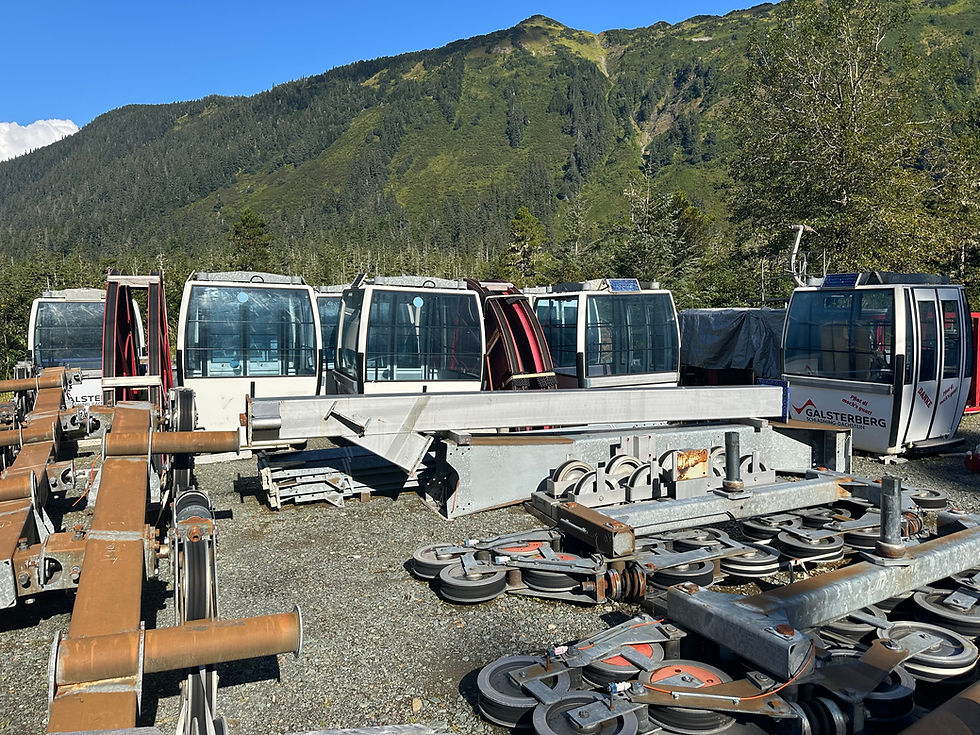Living aboard in Juneau: buoyancy and balance
- Natalie Buttner

- Sep 5
- 5 min read
For affordability or adventure, some Juneauites make a watery escape from the hostile housing market

By Natalie Buttner
Juneau Independent
Despite a low monthly cost of housing, living in Juneau’s harbors requires residents to sacrifice the stability of a life onshore. Some residents say these sacrifices are part of the allure.
On a clear August evening, Pam Bearden sat on the dock in front of her sailboat in Harris Harbor. Her dog, Xena, sniffed at the edges of the dock. This is Bearden’s evening routine.
“It’s my social hour,” she said.
Bearden bartered for her sailboat and home of 33 years. She got the sailboat in exchange for working on the former owner’s house.
“It's that sailboat behind me, but it's my little living space apartment on the water, and you get to rock to sleep,” she said.
Bearden said that she likes the quiet and freedom of where she is in the harbor. Her boat is mostly surrounded by fishermen. She saw living aboard as a liberating alternative to living in a house.
“When you own a house, you got to pay all these bills all the time,” she said. “It's a pretty big burden. I seen my grandparents do that their whole lives, and when they got done and retired, they were just tired; they worked their whole lives for a house.”
The cost of housing in Juneau is notoriously high. According to a report released by the Alaska Department of Labor and Workforce Development in July, the average sales price for a single-family home in Juneau in 2024 was $524,312, with an estimated monthly mortgage of $2,612, the highest average in the state. The study found that the average median adjusted rent for a two-bedroom apartment in Juneau was $1,661.
As of July 1, 2025, the residence surcharge in Juneau harbors is $88.46 per month for up to four people living on a vessel. Any additional person will cost $29.49. Liveaboards also pay moorage rates, which vary by harbor and boat size.
Bearden estimates that she pays $368 a month in harbor fees, between her liveaboard fee and her moorage.
But there are tradeoffs. Bearden hauls her laundry, garbage and sewage up the dock, and carries down wood for her woodstove. She said she tries to do so during high tide, when the ramps to the harbor are less steep.
“It's kept me stronger longer,” Bearden said. “I'm 67 now, so I get constant exercise.”
She also said Southeast Alaska’s climate keeps her on her toes. She covers the boat with tarps to keep out the rain. In the wintertime, owners of boats in the harbor have to remain vigilant of becoming top-heavy from snow. Bearden said one year she woke up to see that the boat next to hers had sunk. “It was hanging by the ropes underwater,” she said.
After three decades living on the water, Bearden was considering moving to Fairbanks to live with her son.
“I don't mind living on the boat, but I'm getting older now where I think it might be a good idea for me to upgrade my living space,” she said.
Peter Nehf is building from the water up. On Aug. 5, he was working on his new floathouse in Aurora Harbor. His original plan was slowed by the challenges of buoyancy and balance. The weight of the walls was pushing the edges of the floor, causing the middle of the floor to bend. Nehf was in the process of fixing the problem by reinforcing the floor to better redistribute weight.
“So ultimately, if I just left it, it could conceivably just collapse in and the walls go straight down,” he said. He laughed, possessing an optimistic sense of humor about this setback.
In addition to having invested $20,000 in the construction of the house, Nehf is currently living in the unfinished floathouse.
“There’s no stopping,” he said.

This is the second floathouse that Nehf has built in the harbor, selling his first when a job opportunity pulled him out of Juneau. In the midst of troubleshooting, Nehf still brightened up talking about being drawn to floathouses. He said that driving through downtown Juneau, he noticed the houseboats lining the harbor and immediately pulled over to wander around the harbor and see more.
“I've had the idea for a floating house for 25 years,” he said. “You see things on the internet, and I always thought that that would be a fascinating way to live.”
Down the dock, Amanda Krause and her children, enjoying the afternoon on the front deck of their boat. Krauses’ older son was filleting a flatfish he caught with instruction from a YouTube video.
For Krause and her family, living aboard began with an adventure sailing up the Inside Passage, ultimately settling in Juneau.
“It’s novel, I guess,” she said. “There was sort of a romantic aspect that made me think it was a good idea.”
Both of her children are homeschooled. Krause said the greatest challenge of raising kids in the harbour is the limited amount of space. They recently upsized from their sailboat into an old Forest Service boat. Their new boat is more spacious, but also expensive to fuel to take out on the water.
Joni Dahlstrom in Douglas Harbor shares an affection for life intertwined with the ocean.
“The whole harbor is like home, is your backyard,” she said. “My backyard is the Treadwell and running out my little boat out down the coast and stuff, and I don't have to mow it.”
Dahlstrom said that every finger of the dock is like a neighborhood zip code, sorted by boat size.
According to Matthew Creswell, City and Borough of Juneau harbormaster, determining who is a liveaboard relies on the honor system, but footsteps in the snow in the wintertime are a telling sign of who is living in the harbor. Creswell also said since docks and harbors have staff working in the harbors around the clock they are able to monitor who is living aboard.
This includes making sure that boats and floathouses are complying with correct sewage disposal, and clearing snow from the docks.
“We are the farthest north harbor in America that has year-round potable water available on the dock,” Creswell said. “One of the big reasons we do that is because of our high level of liveaboards.”

According to Katie McKeown, Docks and Harbors administrative supervisor, there were 98 vessels registered as liveaboards in downtown harbors and 14 in Statter Harbor as of August 20th. She said that these numbers may increase when the fishing season ends in October and fishermen are living aboard their boats for the winter.
CBJ code states all boats in the harbor must “clear the boat harbor under its own power on at least three occasions each year.” Creswell said CBJ Docks and Harbor has taken a more aggressive stance in enforcing this rule in the last few years to help prevent derelict vessel problems.
“We try to keep all these vessels moving and operational, and that includes a lot of liveaboard vessels,” Creswell said. “The only vessels that aren't required to move are designated floathouses.”
Dahlstrom has lived aboard for a total of 12 years, in Hollywood, Florida, and Santa Barbara, California, before Juneau. She believed that liveaboards make harbors safer.
“You can just picture, as soon as it's dark and the place is empty, it's a free-for-all for thieves,” she said. “But we're there and we keep an eye on things.”
Kalvin Culp has been living for about a year in Harris Harbor on a houseboat that once tipped over and sank due to snowload. When he bought it, it was just a shell. Now he is working on restoring it.
He enjoys his neighbors, the sense of community among liveaboards, and the ability to jump in his skiff and go fishing anytime.
“It's cheap and you get the cool factor,” he said.
• Contact Natalie Buttner at natalieb@juneauindependent.com.












